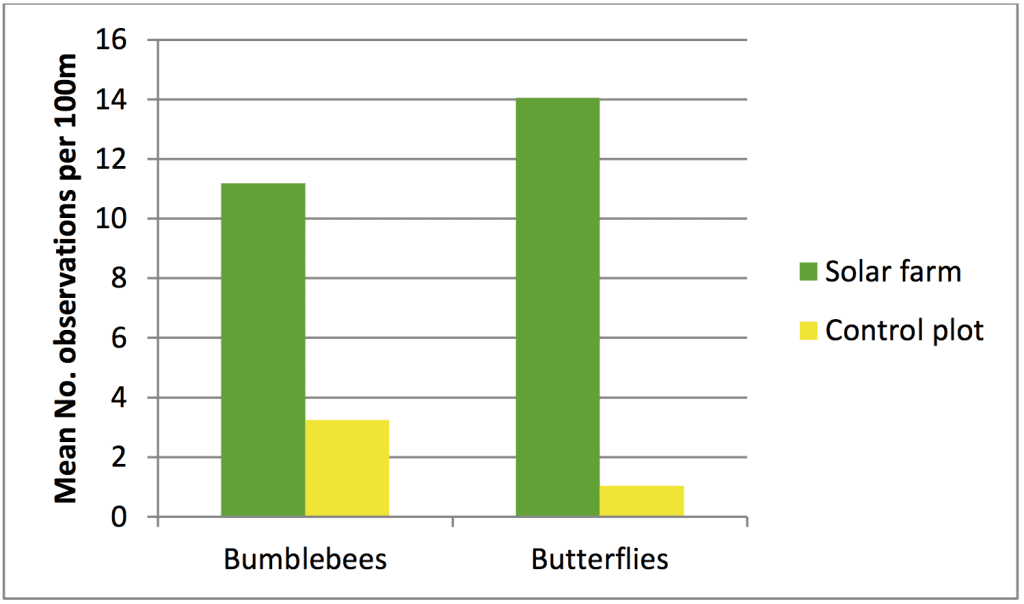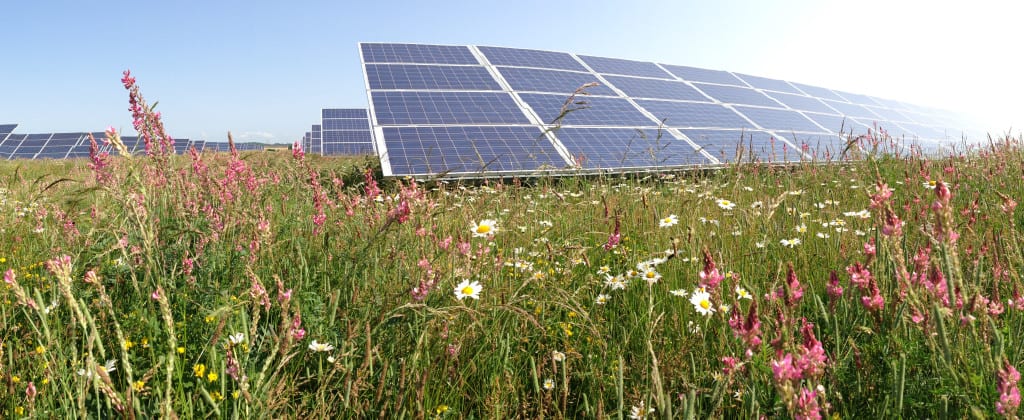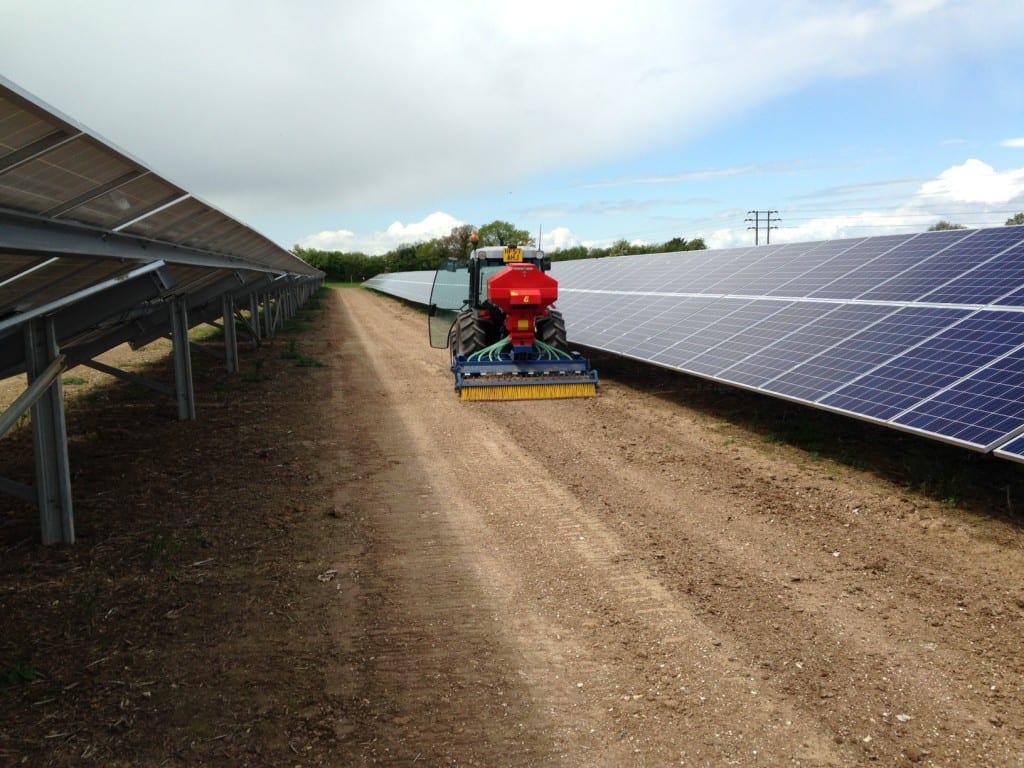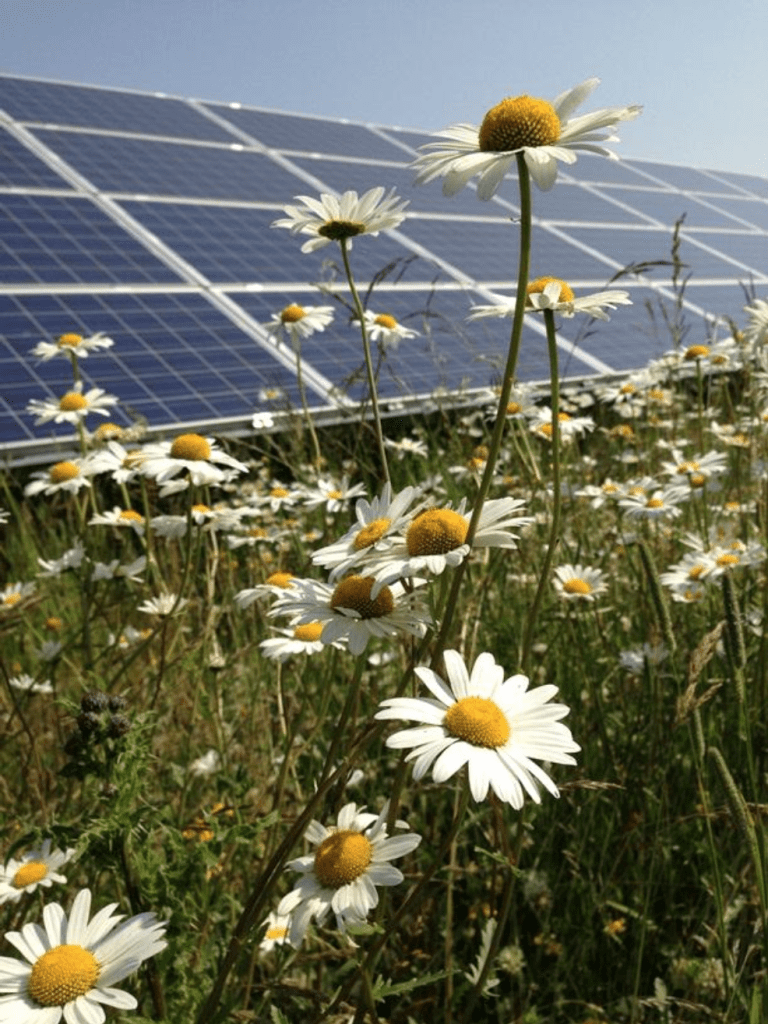Public Benefits from Ecological Landscapes Include Pollinator Habitat, Improved Water and Soil Quality
by Rob Davis
Dramatic changes in cost can drive dramatic changes in customer behavior—and create extraordinary business opportunities. Such is the situation right now with solar energy — hardware costs have plummeted by 80 percent in the last five years and the more we build, the cheaper it gets. The majority of solar installations will be built on arable land, creating business booms for strategic ecological consulting services and in providing bulk seed for low-growing forbs and shade-tolerant native grasses.
In the United Kingdom, where thousands of acres of solar sites with vegetative groundcover were built over the last five years, ecological service providers and seed companies have reported a surge in solar-specific business.
And now throughout the United States more than 100,000 acres of managed landscapes—around and under solar panels—will be built in just the next three years. The change is driven by demand from corporations, states, and electric utilities seeking fuel- and emissions-free energy. Savvy ecological service providers can help maximize the market opportunity by educating the public—creating more demand for vibrant and diverse landscaping on solar sites.

Compared to row crops, solar sites with biodiverse plants show statistically significant increases in pollinator populations and variety. Parker, GE & McQueen, C (2013) Can Solar Farms Deliver Significant Benefits to Biodiversity? Preliminary Study July-August 2013. Unpublished Report.
Ecological Landscapes on Solar Sites: Multiple Benefits
With no moving parts and a free fuel source rising and setting each day, the predictability of solar energy makes it valuable to developers and buyers. Land owners — typically farmers — also benefit from the predictable long-term lease revenue generated by having acreage in solar.
Adding a native landscape to a solar site creates even greater public and private benefits:
Pollinator Habitat: One-third of our food production requires pollinators, as does livestock forage, and most wild plants that produce seeds. However, bees, birds, monarchs, and critical pollinators are disappearing by the hundreds of millions according to research from the U.S. Fish and Wildlife Service. A significant factor in the decline is habitat loss.
Meanwhile, observational studies from the UK and Germany show bees, birds, and butterflies thriving on solar sites planted with a mixture of native grasses and flowering forbs.
Improved Water Management and Soil Conditions: In cooperation with a consortium of 19 cities and towns, the U.S. Geological Survey completed a five-year storm water study that revealed “striking differences between turf and prairie vegetation.” The study found “prairie vegetation had greater median infiltration rates than those with turf grass,” and roots in the prairie vegetation plot were “found to a depth of 4.7 feet compared with 0.46 feet in the turf.”
Ecologists have proven that increasing plant richness by the addition of legumes and forbs to the traditional grasses enhances the functional diversity and stacks benefits provided by these systems. A native landscape on solar sites will both hold the soil in place and significantly improve its quality over the life of the project.
Reducing Fire Risk and Increasing Solar Performance: Though there is not yet research available on the subject, ecologists expect that a higher percentage of native forbs will help reduce the risk of grass fires in some climates. And the National Renewable Energy Laboratory recently began a study to test the hypothesis that solar panels above a vegetative groundcover operate at greater efficiency—due to cooler operating temperatures—compared to panels operating over concrete or gravel.
Public Demand and Policy Can Grow the Market
Your elected officials are already hearing from solar companies. Businesses in your community are actively evaluating how they can save money by using more solar electricity. Will your state be building 2,000 or 20,000 acres of solar sites? And will any of these sites get anything more than gravel or turfgrass? Landscape budgets get squeezed at the last minute all too often.
Work with your elected officials to ensure they understand the public benefits—pollinators and wildlife, water and soil—of native landscapes on solar sites. Conditional use permits—a common tool used by City Councils, County Boards, and Public Utilities Commissions—can call for native landscaping and an appropriate vegetative management plan. An acre of solar panels and hardware alone can cost a third to a half-million dollars—the cost for an acre of quality seed mix just doesn’t compare.
And if engaging with elected officials isn’t your strong suit, support the nonprofit organizations that are taking on this work. For example, Nick Mann is the founder and president of Habitat Aid, a native seed, plant, and habitat management business. Each year Mann contributes 50 percent of all his profits from online sales back to conservation organizations. Mann has secured several large corporate clients including Nestle and Solar Century and has provided seed consulting and planting services on more than 50 multi-acre solar parks throughout the United Kingdom.
Nationwide, the 2016 outdoor construction season is upon us. And seed and landscape service companies including Ernst Seeds and Prairie Restorations are actively marketing their solar services and contributing to nonprofits. Now is the time for the ecological landscape industry to get involved, grow the market for their businesses, and help create a world where the benefits from solar energy come from the panels as well as what’s grown underneath.
About the Author
Rob Davis helped launch Firefox 1.0 and tells the stories of pioneering people, ideas, and organizations. Davis works at Fresh Energy, an independent 501(c)3 nonprofit. Free Video links to Davis’ talk at the VERGE sustainability summit about pollinator habitat on solar sites.
Each author appearing herein retains original copyright. Right to reproduce or disseminate all material herein, including to Columbia University Library’s CAUSEWAY Project, is otherwise reserved by ELA. Please contact ELA for permission to reprint.
Mention of products is not intended to constitute endorsement. Opinions expressed in this newsletter do not necessarily represent those of ELA’s directors, staff, or members.




